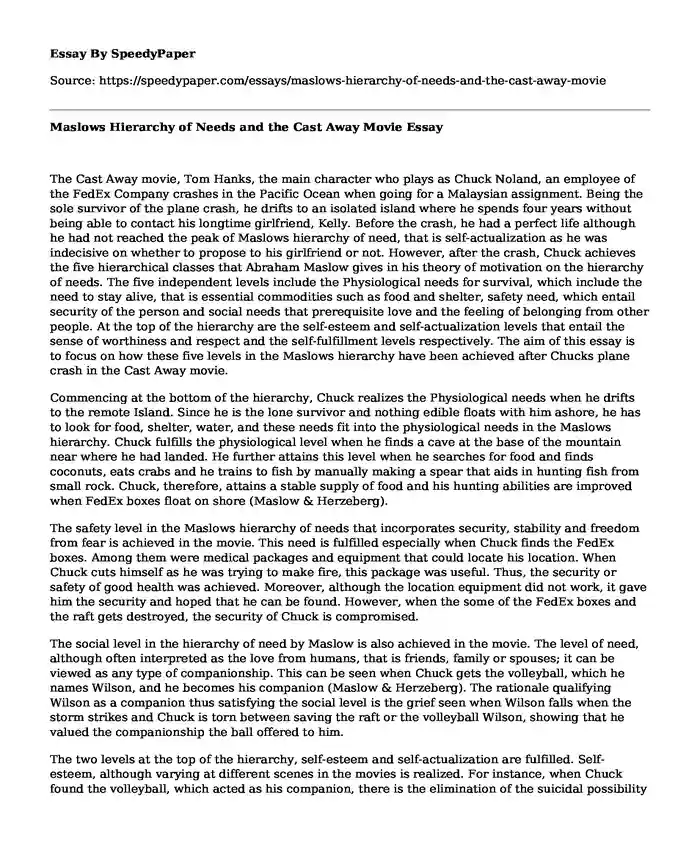The Cast Away movie, Tom Hanks, the main character who plays as Chuck Noland, an employee of the FedEx Company crashes in the Pacific Ocean when going for a Malaysian assignment. Being the sole survivor of the plane crash, he drifts to an isolated island where he spends four years without being able to contact his longtime girlfriend, Kelly. Before the crash, he had a perfect life although he had not reached the peak of Maslows hierarchy of need, that is self-actualization as he was indecisive on whether to propose to his girlfriend or not. However, after the crash, Chuck achieves the five hierarchical classes that Abraham Maslow gives in his theory of motivation on the hierarchy of needs. The five independent levels include the Physiological needs for survival, which include the need to stay alive, that is essential commodities such as food and shelter, safety need, which entail security of the person and social needs that prerequisite love and the feeling of belonging from other people. At the top of the hierarchy are the self-esteem and self-actualization levels that entail the sense of worthiness and respect and the self-fulfillment levels respectively. The aim of this essay is to focus on how these five levels in the Maslows hierarchy have been achieved after Chucks plane crash in the Cast Away movie.
Commencing at the bottom of the hierarchy, Chuck realizes the Physiological needs when he drifts to the remote Island. Since he is the lone survivor and nothing edible floats with him ashore, he has to look for food, shelter, water, and these needs fit into the physiological needs in the Maslows hierarchy. Chuck fulfills the physiological level when he finds a cave at the base of the mountain near where he had landed. He further attains this level when he searches for food and finds coconuts, eats crabs and he trains to fish by manually making a spear that aids in hunting fish from small rock. Chuck, therefore, attains a stable supply of food and his hunting abilities are improved when FedEx boxes float on shore (Maslow & Herzeberg).
The safety level in the Maslows hierarchy of needs that incorporates security, stability and freedom from fear is achieved in the movie. This need is fulfilled especially when Chuck finds the FedEx boxes. Among them were medical packages and equipment that could locate his location. When Chuck cuts himself as he was trying to make fire, this package was useful. Thus, the security or safety of good health was achieved. Moreover, although the location equipment did not work, it gave him the security and hoped that he can be found. However, when the some of the FedEx boxes and the raft gets destroyed, the security of Chuck is compromised.
The social level in the hierarchy of need by Maslow is also achieved in the movie. The level of need, although often interpreted as the love from humans, that is friends, family or spouses; it can be viewed as any type of companionship. This can be seen when Chuck gets the volleyball, which he names Wilson, and he becomes his companion (Maslow & Herzeberg). The rationale qualifying Wilson as a companion thus satisfying the social level is the grief seen when Wilson falls when the storm strikes and Chuck is torn between saving the raft or the volleyball Wilson, showing that he valued the companionship the ball offered to him.
The two levels at the top of the hierarchy, self-esteem and self-actualization are fulfilled. Self-esteem, although varying at different scenes in the movies is realized. For instance, when Chuck found the volleyball, which acted as his companion, there is the elimination of the suicidal possibility seen when he climbs at the top of the mountain. This shows the relationship between the social level in Maslows hierarchy and this phase. Self-esteem is mainly catalyzed or influence with the social aspects of life, and Chuck gets a sense of self-worth especially when he finds Wilson. Furthermore, when he is able to get food for himself via hunting and other means, his self-worthiness increase as he sees the worthiness of living (A. Maslow, A Theory of Human Motivation). Chuck further illustrates self esteem when he decides to use the raft in the pursuit of help.
Finally, the Self-actualization level is attained after Chuck is saved from the island. Chuck achieves this level by first getting back into the real world. He realizes that he had taken everything for granted and begins to realize the importance of everything he had taken for granted. Most importantly, he resolute to marry Kelly but disappointed when he realized he was married. This, however, does not limit his want for self-fulfillment as he even takes the wings from the unopened FedEx box to the owner with lots of gratitude. Chuck resolves to appreciate his friends more thus, he changes into a new man who takes life one day at a time as a result of the experiences he had on the isolated island. Therefore, the five levels of Maslows hierarchy of needs were fulfilled (A. Maslow, A Theory of Human Motivation).
Works Cited
Cast Away. Dir. Robert Zemeckis. Perf. Tom Hanks. 2000.
Maslow, Abraham, and A. Herzeberg. "Hierarchy of needs." AH Maslow. ea., Motivation and Persona/ity. Harper, New York (1954).
Cite this page
Maslows Hierarchy of Needs and the Cast Away Movie. (2019, Jun 04). Retrieved from https://speedypaper.net/essays/maslows-hierarchy-of-needs-and-the-cast-away-movie
Request Removal
If you are the original author of this essay and no longer wish to have it published on the SpeedyPaper website, please click below to request its removal:
- Articles Analysis Example on Software Evolution
- Race in the 21st Century. Free Essay Example.
- Free Essay Example: Socialism vs. Capitalism
- World Affairs: Importance of Mabo Decision, Law Essay Sample
- Free Essay: Injustice in the Criminal System
- Paper Example on The Return of Martin Guerre
- Exploring the Diversity of Asian Cultures: A Comparative Analysis - Essay Sample
Popular categories





